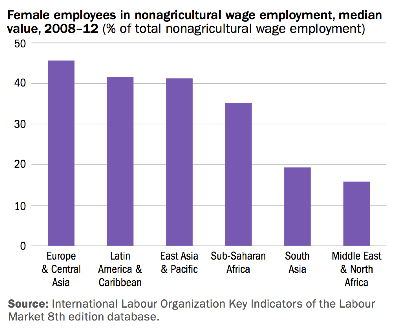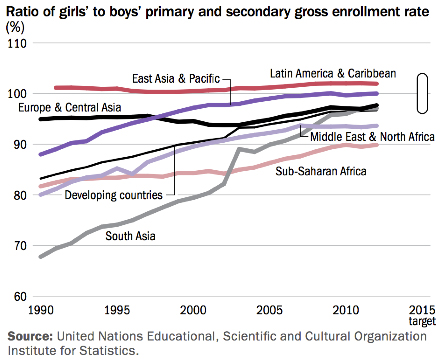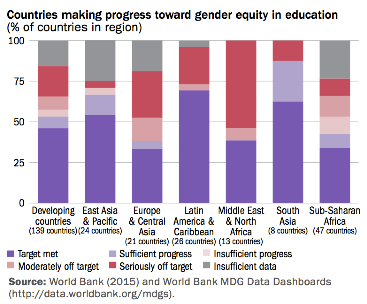This is the third in a series of posts on data related the Millennium Development Goals based on the 2015 Edition of World Development Indicators.
Millennium Development Goal 3 is to “Promote gender equality and empower women” and is measured against a target to “Eliminate gender disparity in primary and secondary education, preferably by 2005, and in all levels of education no later than 2015” and also includes indicators to measure the proportion of seats held by women in national parliament and the share of women in wage employment in the non-agricultural sector.
Since 1990, the number of women in parliament has quadrupled in the Middle East and North Africa
 More women are participating in public life and decision making at the highest levels than in 1990, based on the proportion of parliamentary seats held by women. Latin America and the Caribbean leads developing country regions in 2014, at 29 percent, followed closely by Sub-Saharan Africa at 22 percent. The biggest change has occurred in the Middle East and North Africa, where the proportion of seats held by women more than quadrupled between 1990 and 2014 . At the country level Rwanda leads the way with 64 percent in 2014, higher than the percentage for high- income countries, at 26 percent.
More women are participating in public life and decision making at the highest levels than in 1990, based on the proportion of parliamentary seats held by women. Latin America and the Caribbean leads developing country regions in 2014, at 29 percent, followed closely by Sub-Saharan Africa at 22 percent. The biggest change has occurred in the Middle East and North Africa, where the proportion of seats held by women more than quadrupled between 1990 and 2014 . At the country level Rwanda leads the way with 64 percent in 2014, higher than the percentage for high- income countries, at 26 percent.
Fewer women than men in nonagricultural wage employment
The share of women’s paid employment in the nonagricultural sector is less than 20 percent in South  Asia and the Middle East and North Africa and has risen only marginally over the years. The share of women’s employment in the nonagricultural sector is highest in Europe and Central Asia, where it almost equals men’s.
Asia and the Middle East and North Africa and has risen only marginally over the years. The share of women’s employment in the nonagricultural sector is highest in Europe and Central Asia, where it almost equals men’s.
Women work long hours and contribute considerably to their families’ economic well-being, but many are unpaid for their labor or work in the informal sector. These precarious forms of work, often not properly counted as economic activity, tend to lack formal work arrangements, social protection, and safety nets and leave workers vulnerable to poverty.
Gender gaps in access to education have narrowed
Over t he past 25 years, girls have made substantial gains in school enrollment across all developing country regions. In 1990 the average enrollment rate of girls in primary and secondary schools indeveloping countries was 83 percent of that of boys; by 2012 it had increased to 97 percent. The ratio of girls to boys in tertiary education has also increased considerably, from 74 percent to 101 percent.
he past 25 years, girls have made substantial gains in school enrollment across all developing country regions. In 1990 the average enrollment rate of girls in primary and secondary schools indeveloping countries was 83 percent of that of boys; by 2012 it had increased to 97 percent. The ratio of girls to boys in tertiary education has also increased considerably, from 74 percent to 101 percent.
Gender disparities in primary and secondary education vary within regions
 However, these averages disguise large differences across regions and countries. About half the countries in the Middle East and North Africa are seriously off track to achieve the target of gender parity. Sub-Saharan Africa and the Middle East and North Africa saw fast progress but continue to have the largest gender disparities in primary and secondary enrollment rates among developing country regions. Given past rates of change, the two regions are unlikely to meet the target of eliminating disparities in education by 2015. -http://blogs.worldbank.org/opendata/mdg3-large-differences-gender-equality-between-and-within-countries
However, these averages disguise large differences across regions and countries. About half the countries in the Middle East and North Africa are seriously off track to achieve the target of gender parity. Sub-Saharan Africa and the Middle East and North Africa saw fast progress but continue to have the largest gender disparities in primary and secondary enrollment rates among developing country regions. Given past rates of change, the two regions are unlikely to meet the target of eliminating disparities in education by 2015. -http://blogs.worldbank.org/opendata/mdg3-large-differences-gender-equality-between-and-within-countries
#WearMask #WashHands
#Distancing
#TakePicturesVideos

